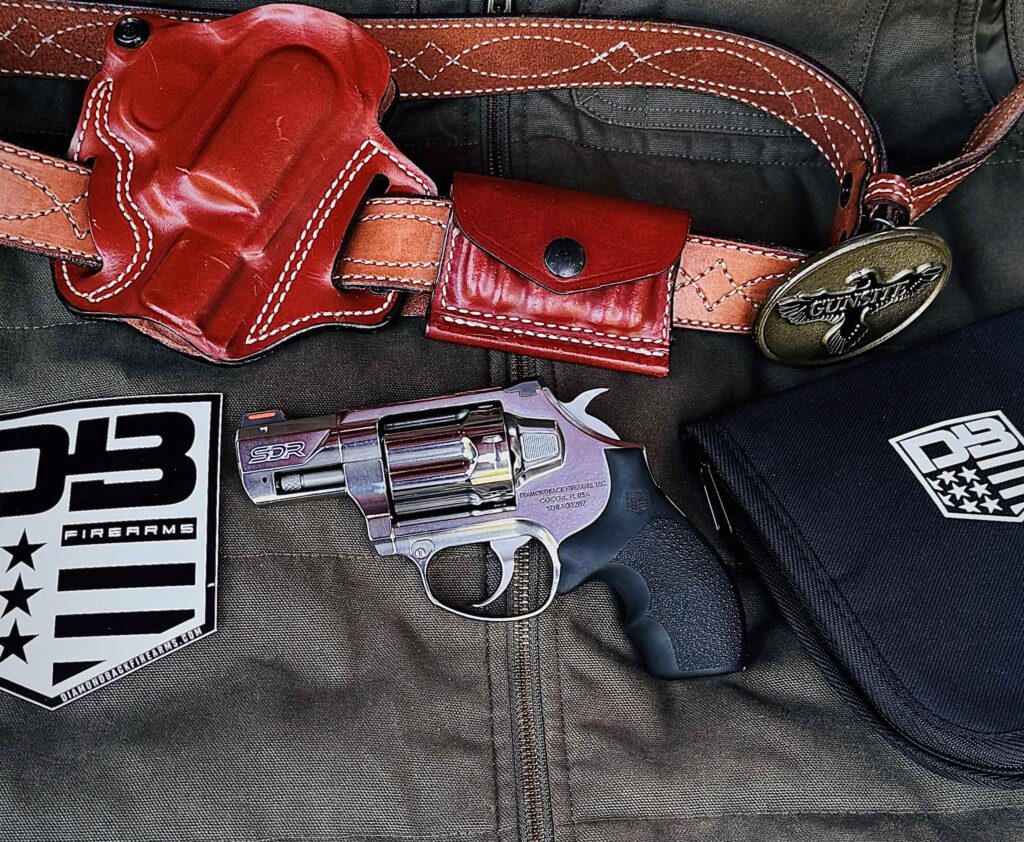A New .357 Magnum Double Action Revolver for EDC
I was initially introduced to the Diamondback Firearms SDR (Self Defense Revolver) at a writer’s conference. The writers in attendance got to see the SDR during a classroom presentation, then have some range time with it. I saw the SDR again at the 2024 SHOT Show Industry Day at the range and burned a little more powder with one. I was impressed on both occasions and clamored for a test gun. An SDR arrived on my doorstep four months later.
Back when I first saw the SDR, I was struck by its appearance. It was “space-age” looking, with features found on other popular double action (DA), swing-out cylinder revolvers. I could see Kimber K6s influence in its angular look, rear sight dovetailed into the frame, and push-in cylinder release latch. The six-shot cylinder was styled like the cylinder on the Ruger LCR. Its trigger guard was about the same shape and size as the Colt Cobra, then on the right side of the frame, just above the front of the of the trigger guard, is a push-button. Pressing it in with the cylinder swung out, allows quick removal of the captured crane-link cylinder assembly, just like the Taurus 692/992 revolvers. Lastly, the cylinder lock-up points at the rear of the cylinder/breech-face, and at the end of the ejector rod are classic Smith & Wesson. As is the shape and size of the grip-frame, which mimic the J-frame.
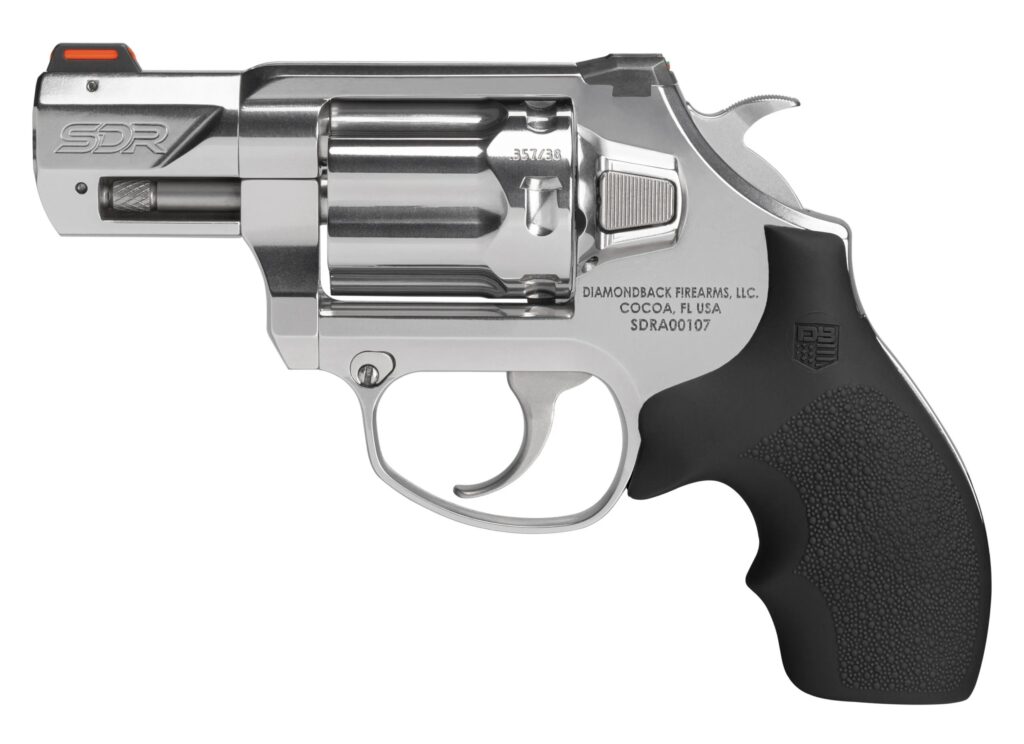
The discerning reader will note the SDR has a lot in common with the Kimber K6s, Ruger LCR, Colt Cobra, and S&W J-frames.
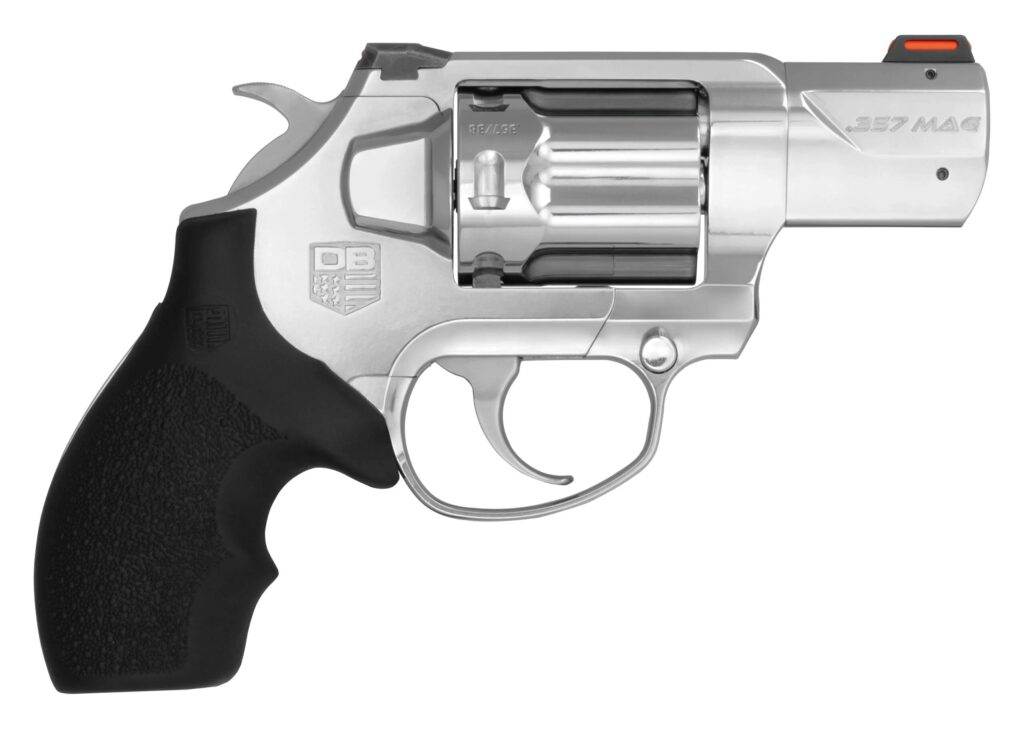
On the right side of the frame is a button near the top of the trigger guard; with the cylinder swung out, pressing that button releases the cylinder-crane assembly
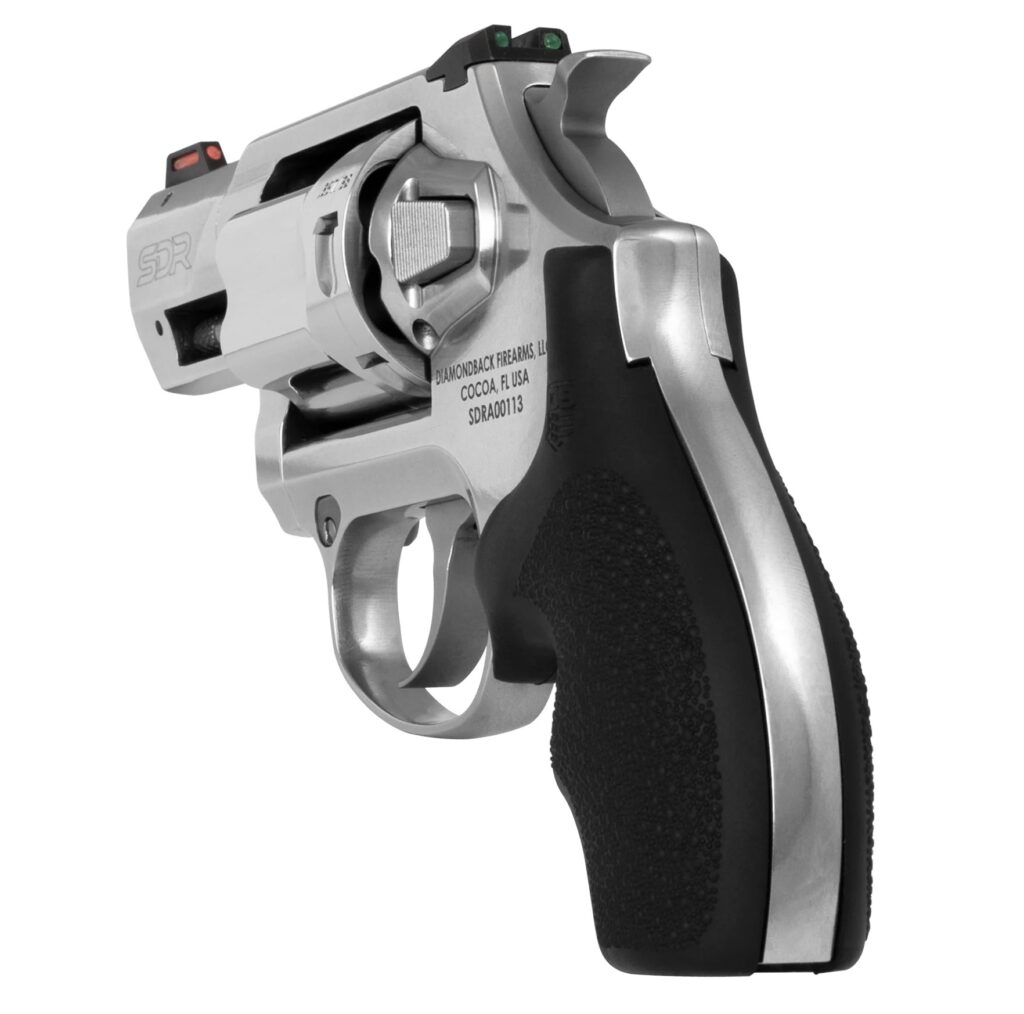
This image offers a view of the fiber-optic sights and the push-in cylinder release latch; the rubber grips are made for Diamondback by Hogue.
The has a solid stainless-steel frame, cylinder, and 2” barrel, and an empty weight of 21.2 oz. This is pretty light considering it’s chambered in .357 Magnum, and will also take .38 Special cartridges. It has a traditional DA/SA, with a smooth, non-stacking pull weight of 9-11.5 lbs. The SA pull has no take-up or creep and breaks at about 3.5 lbs. The trigger is smooth-faced and 0.25” wide; the SDR has an exposed hammer, and the spur is serrated. A transfer bar type mechanism prevents accidental discharges unless the trigger is deliberately pulled.
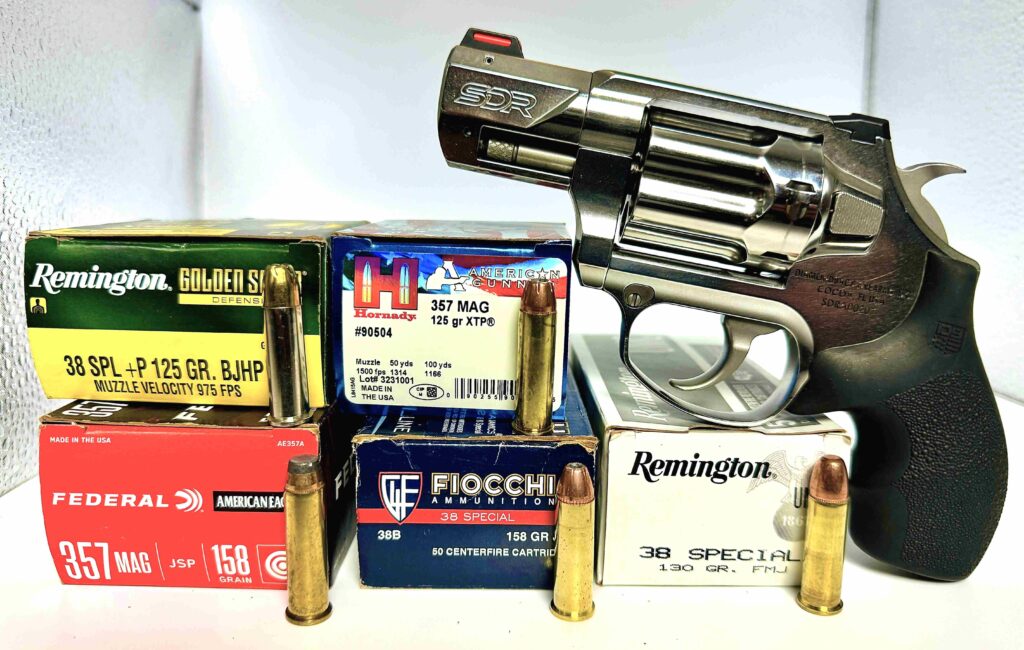
Two .357 Magnum loads and three .38 Special cartridges from four manufacturers were used in the SDR shooting test.
My test SDR has a barrel that is round where it meets the frame, then an angular cut makes it flat-sided, plus it has an integral ejector rod shroud. At the muzzle is a 45° precision target crown that protects the rifling and preserves accuracy. Pinned into the top of the barrel is an orange fiber-optic front sight. The rear sight is black and has a square notch, flanked on each side by green fiber-optic elements. Both are low-profile, providing a contrasting 3-dot combination. The cylinder is chamfered in the rear to enclose the cartridge case heads. The generously sized cylinder release latch is embedded in an extension of the recoil shield, and is finely serrated. Hogue black rubber grips, branded with the Diamondback logo, have pebble-grain texturing. The grips leave the backstrap and butt of the grip-frame exposed. Also notable on the SDR is an excellent polish-job and that give the appearance of fine nickel plating; the markings are tasteful and minimal. The SDR comes in a black nylon zipper case.
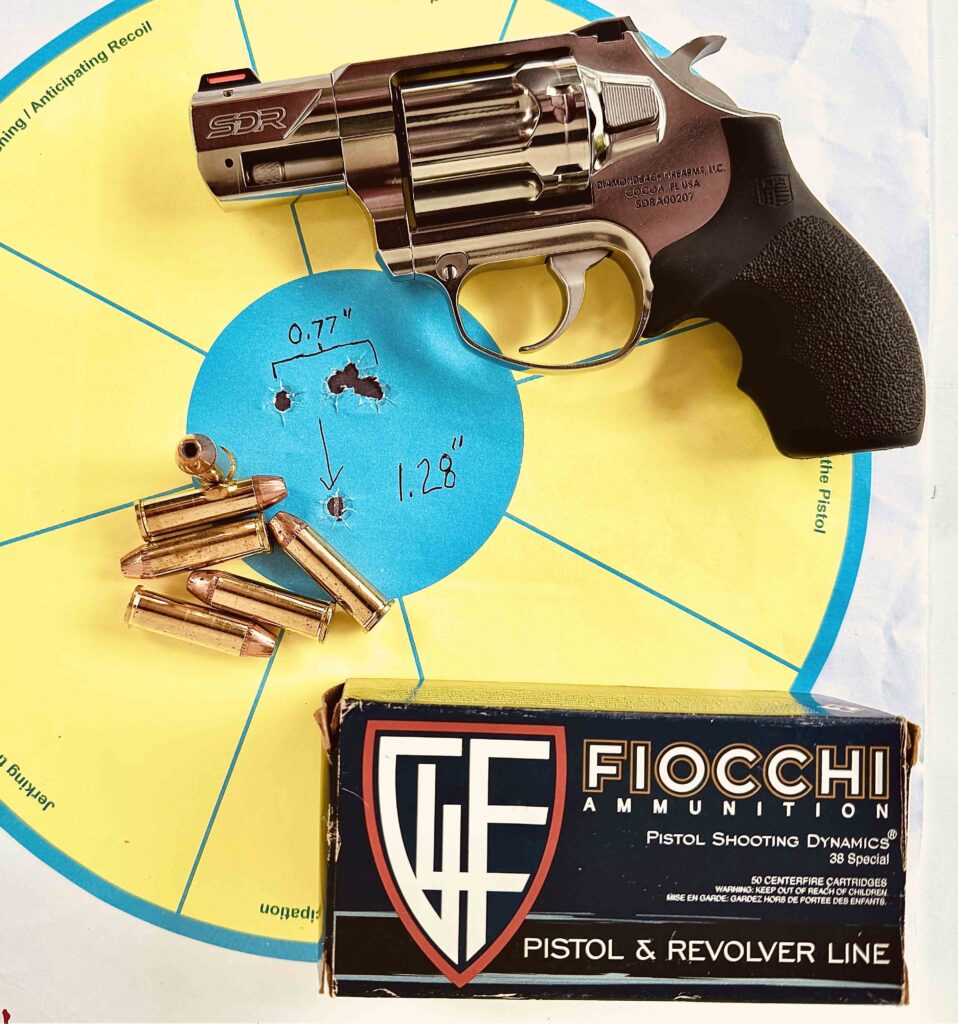
At 10 yards a sub-one-inch group was ruined by a flyer using the Fiocchi 158 gr. JHP .38 Special ammo; shooting was done from a rest, single action.
I decided two .357 Magnum loads in my T&E, plus three .38 Special loads for the shooting evaluation. From Federal, I chose the American Eagle .357 cartridge, with a 158 gr. JSP bullet. Fiocchi offered their .38 Special cartridges with a 158 gr. JHP. The other .357 load was Hornady American Gunner, with a 125 gr. XTP-HP bullet. Two other .38 Special loads the Remington-UMC with 130 gr. FMJ bullets, and their .38 Special Golden Saber, with a 125 gr. brass JHP, rated +P.
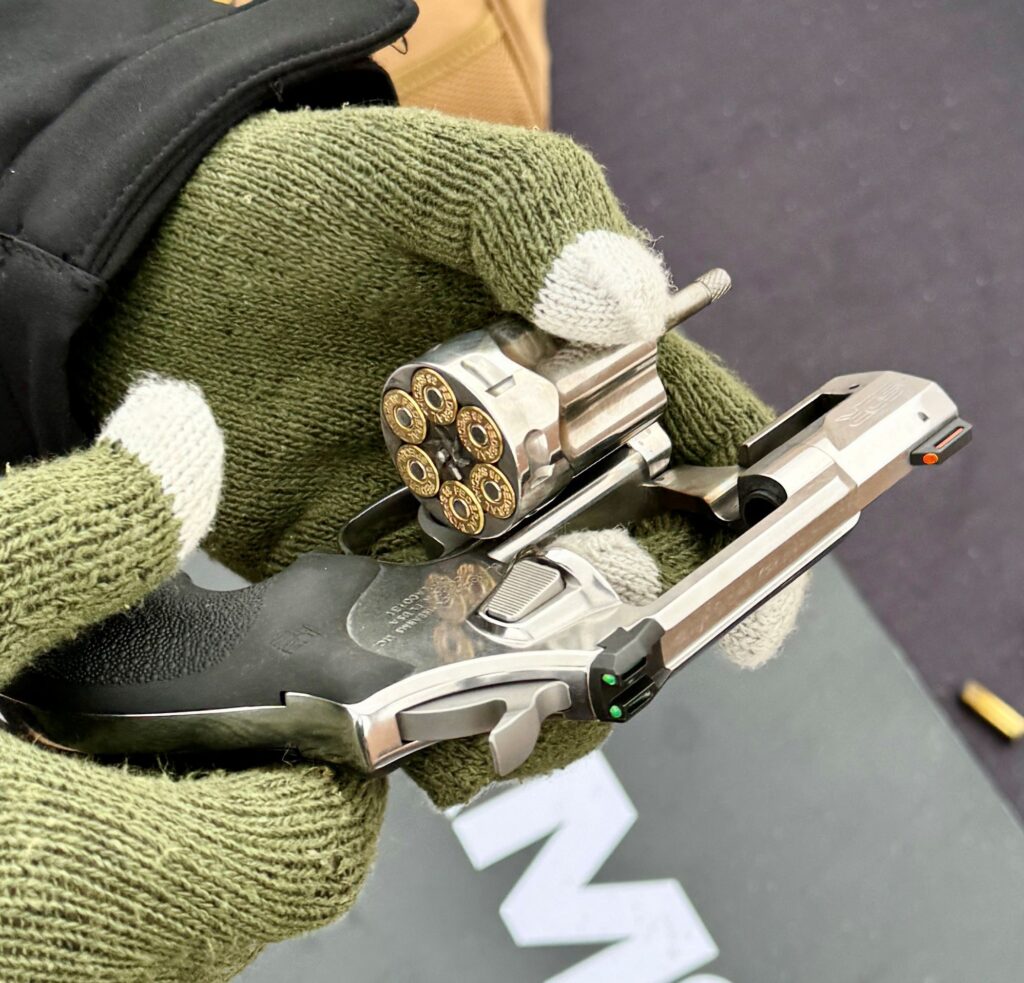
A feature generally not seen on today’s revolvers is a chamfered cylinder that encloses the cartridge case heads; the short ejector rod posed no problems.
My range dates were split. I used an indoor range for the bullseye, paper-punching accuracy testing, and an outdoor range to shoot the SDR through my chronograph for bullet velocity measurements. I also did my combat shooting course outdoors. To pack the SDR for the practical shooting stage, I used a DeSantis #172-6D FLETC 2.0 leather holster, that has an attached cartridge pouch. It’s an OWB high-ride, pancake style, with attributes that make it perfect for concealed carry. This was mated with a DeSantis Swift Strip to carry the extra ammo in the pouch. The shuck was hung on a veteran Bianchi #B12 “Fancy Stitched” 1.5” wide belt, that is thick for good gun/holster support.
Shooting Test #1 was conducted at a local Range USA facility. Shooting was done using a range table that I could put my sandbag on and I used a folding stool. A multi-bullseye target sheet sent down to the 10-yard line. I shot SA, with three 5-shot groups fired using each of the 5 test cartridges. With the exposed backstrap and the SDRs light weight, the .357 Magnums bucked like a rodeo bull, so I slipped on a shooting glove. The accuracy award went to the Fiocchi .38 Special 158 gr. JHP. I had a 0.77” 4-shot cluster going, until a flyer opened the group up to 1.28.” The three-group average was 1.79.” None of the group averages were over 2.5” and the rest of the group data can be seen in the performance table. Point of aim/point of impact was good, considering the different bullet weights and velocities.
Shooting Test #2 was done at an outdoor range location. I performed my chronographing chores and the data is recorded in the performance table. Next, I erected my target stand and attached a realistic “bad guy” target. My paper foe was pointing a pistol and light grey scoring lines, delineate 5, 4 and 3-point scoring zones. I had a good supply of the Remington-UMC .38 Special 130 gr. FMJ ammo, and decided to use it for the practical course. I loaded the SDR, then put 6 rounds in the DeSantis Swift Strip, which was tucked in the cartridge pouch. The course would entail shooting 24 rounds, from “bad breath” distance to 10 yards from the target. All shooting began from the holster, with reloads performed as required.
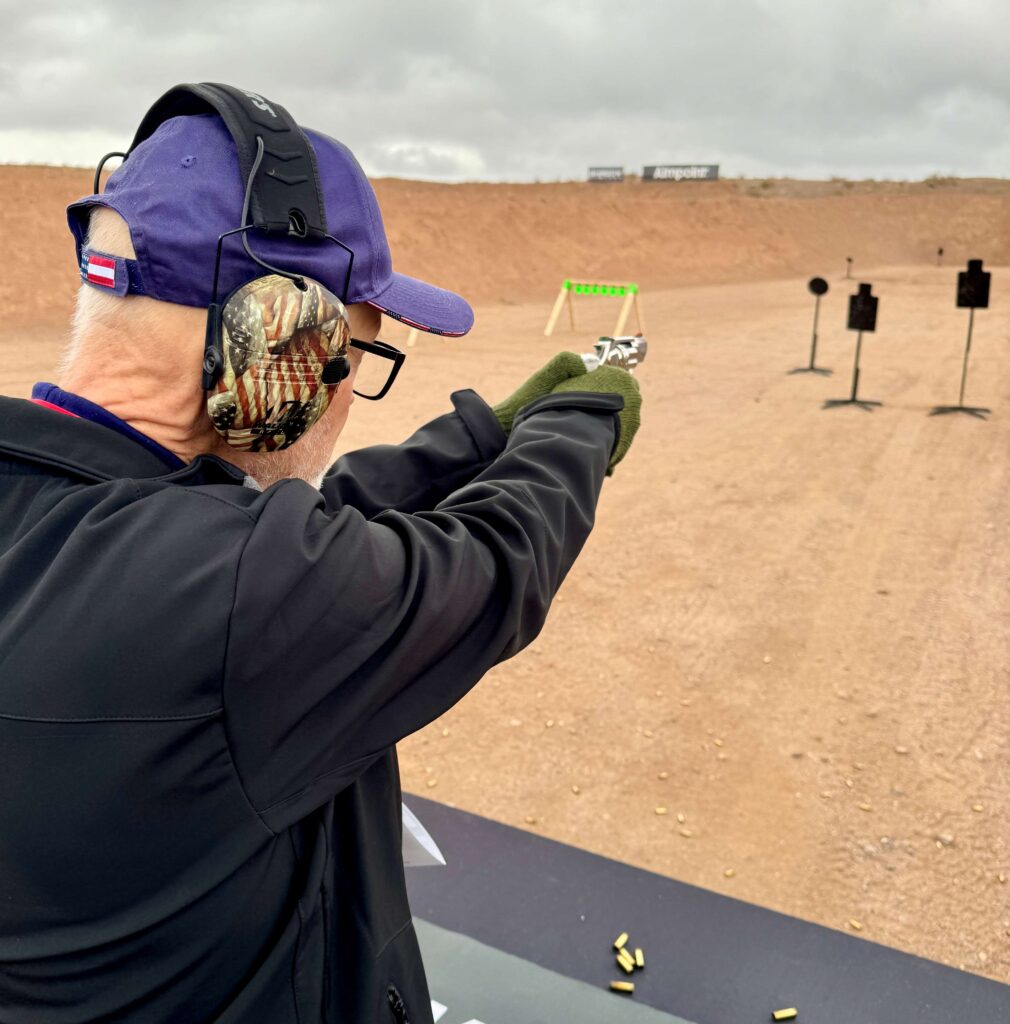
During Industry Day at the Range at the 2024 SHOT Show, the author got to burn some powder with the new SDR shooting at steel targets.
Moving about two feet back from the target stand, I placed my support hand on the target, gave the target a slight push, then drew and fired 2 rounds one-handed. The SDR was clutched close to my side to circumvent a gun grab. Next, I stepped to my right and back 2 yards, where I fired two more rounds, strong-hand only, the weapon raised to the point-shoulder position. I backed to the 5-yard line, gained some distance, and shot my last two rounds point shoulder. Now I withdrew to the 7-yard line, sought cover (a folding table set on its side), and reloaded with the Swift Strip. Here I used the sights, and I shot a series of double-taps, checking the threat after every two shots. I again loaded using the Swift Strip, then fired a “failure drill,” two shots center mass and one to the head. This was repeated, then another reload from behind cover. At 10 yards I used the folding table to simulate a barricade, then from a kneeling position, shot 6 rounds from the right-side barricade. If all hits were in the 5-Zones, possible score was 120 points.
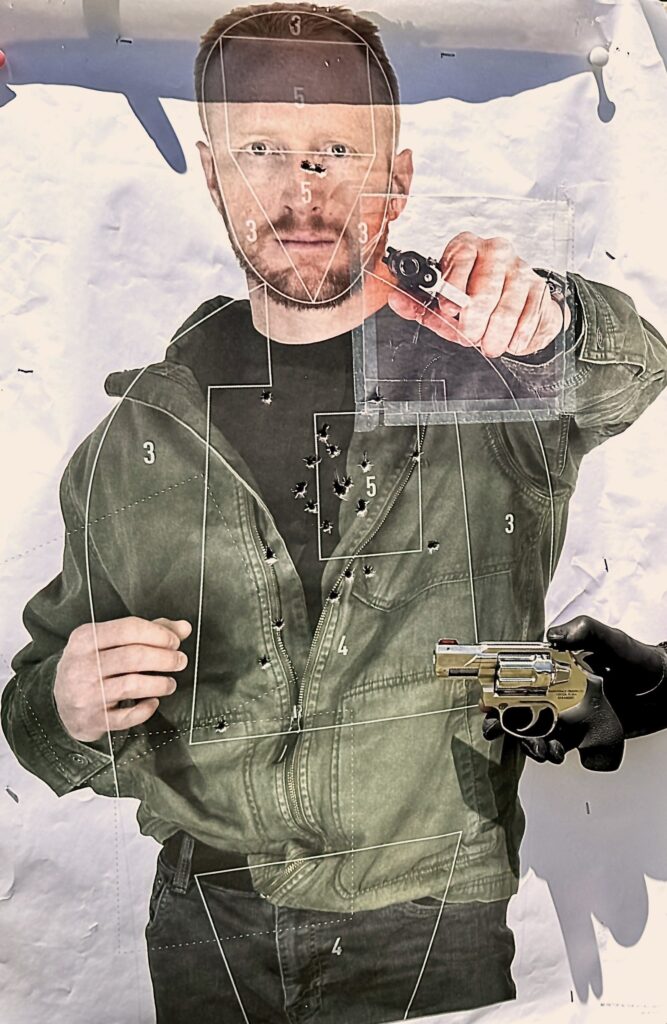
Here you can see the results of the author’s 24-round combat course that was shot in 6 stages, from 2 feet to 10 yards, all double action; check out the head shots.
My score with the SDR was 107/120. Thirteen of the center-mass shots went out into the 4-Zone, but were still impacting “Boiler Room.” The two head shots were both 5’s; both holes touching on the bridge of the nose. The SDR was easy for me to control in rapid fire using the standard-pressure .38 Special loads. The Hogue rubber grips helped with the muzzle flip, and aided in natural pointing. Unlike one brand of small-frame revolver, the cylinder release latch on the SDR never chewed up my right thumb. The fiber-optic sights were easy to acquire and provided an outstanding “flash” sight picture. There were no issues with the DA trigger pull and the short ejector rod punched out the spent cartridge cases without fail, using the proper process. The Swift Strips, holster, cartridge pouch and belt all met expectations. The only thing on my wish-list would be a 9mm conversion cylinder assembly. If you are looking for a revolver to use as an EDC, I would give the Diamondback Firearms SDR all due consideration.
Additional Information
Diamondback Firearms: www.diamondbackfirearms.com
DeSantis Gunhide: www.desantisholster.com
Bianchi: www.bianchileather.com
Diamondback Firearms SDR Specifications
MECHANISM: Traditional DA/SA revolver w/transfer bar
CALIBER: .357 Magnum/.38 Special
CAPACITY: 6 cartridges
BARREL: 2.0 “
OA LENGTH: 6.53”
EMPTY WEIGHT: 21.2 oz.
SIGHTS: Fiber-optic front, fixed fiber-optic rear
FINISH: Polished stainless steel
STOCKS: Hogue DB Firearms-branded, black rubber
MSRP: $777.00
Diamondback Firearms SDR Performance
| Cartridge | Ave. Velocity | Best Group | Average Group |
| Federal American Eagle .357 Mag. 158 gr. JSP | 934 FPS | 1.49” | 2.08” |
| Fiocchi .38 Spl. 158 gr. JHP | 713 FPS | 1.28” | 1.79” |
| Hornady American Gunner .357 Mag. 125 gr. XTP-HP | 1172 FPS | 2.15” | 2.38” |
| Remington-UMC .38 Spl. 130 gr. FMJ | 756 FPS | 1.41” | 1.90” |
| Remington Golden Saber .38 Spl. +P 125 gr. BJHP | 819 FPS | 1.92” | 2.22” |
NOTE: Bullet weight measured in grains, velocity in feet per second 10 ft. from the muzzle by an Oehler Model 35P chronograph, and accuracy in inches for three 5-shot groups at 10 yards.

